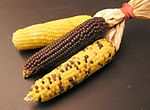Purple corn
This article is in the process of being translated from Maíz Morado in the Spanish-language Wikipedia. In order to reduce edit conflicts, please consider not editing it while translation is in progress. |

Purple corn (Spanish: maíz morado) or purple maize is a variety of flint maize (Zea mays indurata) originating from South America. It is more commonly seen in Peru, Bolivia, Colombia and Ecuador.
Uses[]
Common in Peru, purple corn is used in chicha morada, a drink made by boiling ground purple corn kernels with pineapple, cinnamon, clove, and sugar, and in mazamorra, a type of pudding. One of the most popular purple corn food uses is the "Api", a smoothie served hot and sometimes called "Inca's dessert".[1]
Color chemistry: anthocyanins[]
The pigment giving purple corn its vivid color derives from an exceptional content of a class of polyphenols called anthocyanins. Cyanidin 3-O-glucoside, also called chrysanthemin, is the major anthocyanin in purple corn kernels, comprising about 73% of all anthocyanins present.[2][3][4] Other anthocyanins identified are pelargonidin 3-O-β-D-glucoside, peonidin 3-O-β-D-glucoside, , and .[2][3][4] Similar results for anthocyanin content were found from a variety of purple corn grown in China.[5]
Evaluating growing conditions for anthocyanin and total polyphenol content, one research group found that field location was an important determinant, whereas seedling density and soil potassium content were not.[6]
For ease of extractions, scientists have explored components of the purple corn plant for yield, such as kernels, cob and husk, possibly allowing use of a plentiful, non-edible residual biomass in cobs or husks. Husks of the purple corn plant contain about ten times higher content of anthocyanins than do kernels.[4]
References[]
- ^ "De Arequipa a Mistura: Api, una mazamorra bebible hecha con maíz morado". El Comercio Peru. Retrieved 21 Feb 2013.
- ^ Jump up to: a b Aoki H, Kuze N, Kato Y (n.d.). "Anthocyanins isolated from purple corn (Zea mays L.)" (PDF). unidentified manuscript. Archived from the original (PDF) on 29 October 2013. Retrieved 19 June 2014.CS1 maint: uses authors parameter (link)
- ^ Jump up to: a b Cuevas Montilla, E; Hillebrand, S; Antezana, A; Winterhalter, P (2011). "Soluble and bound phenolic compounds in different Bolivian purple corn ( Zea mays L.) cultivars". Journal of Agricultural and Food Chemistry. 59 (13): 7068–74. doi:10.1021/jf201061x. PMID 21639140.
- ^ Jump up to: a b c Li, C. Y.; Kim, H. W.; Won, S. R.; et al. (2008). "Corn husk as a potential source of anthocyanins". Journal of Agricultural and Food Chemistry. 56 (23): 11413–6. doi:10.1021/jf802201c. PMID 19007127.
- ^ Zhao, X; Corrales, M; Zhang, C; Hu, X; Ma, Y; Tauscher, B (2008). "Composition and thermal stability of anthocyanins from chinese purple corn ( Zea mays L.)". Journal of Agricultural and Food Chemistry. 56 (22): 10761–6. doi:10.1021/jf8025056. PMID 18950186.
- ^ Jing, P; Noriega, V; Schwartz, S. J.; Giusti, M. M. (2007). "Effects of growing conditions on purple corncob (Zea mays L.) anthocyanins". Journal of Agricultural and Food Chemistry. 55 (21): 8625–9. doi:10.1021/jf070755q. PMID 17880157.
- Maize varieties
- Crops originating from western South America

